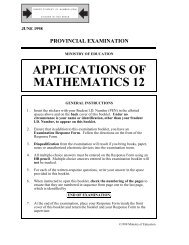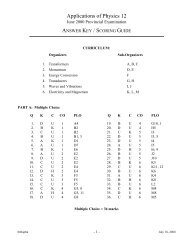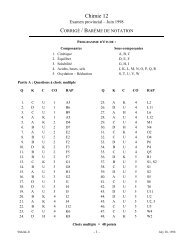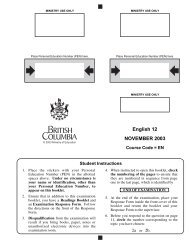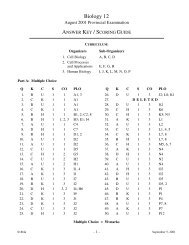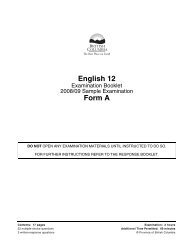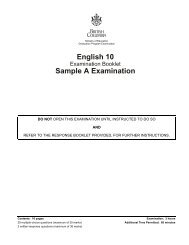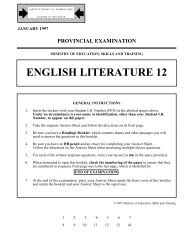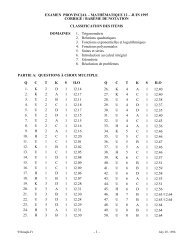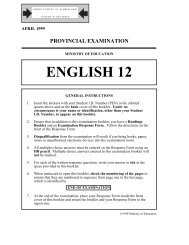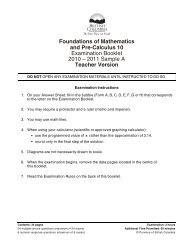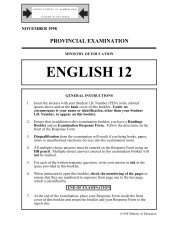English Literature 12 - QuestionBank.CA
English Literature 12 - QuestionBank.CA
English Literature 12 - QuestionBank.CA
You also want an ePaper? Increase the reach of your titles
YUMPU automatically turns print PDFs into web optimized ePapers that Google loves.
<strong>English</strong> <strong>Literature</strong> <strong>12</strong><br />
January 1998 Provincial Examination<br />
ANSWER KEY / SCORING GUIDE<br />
Topics: 1. Literary Selections<br />
2. Literary Forms and Techniques<br />
3. Recognition of Authors and Titles<br />
4. Sight Passages<br />
5. Shakespearean Drama<br />
6. General Essay<br />
Multiple Choice<br />
Q K C T Q K C T<br />
1. C K 1 16. C K 3<br />
2. D K 1 17. D K 3<br />
3. B K 1 18. A K 3<br />
4. D K 1 19. C K 3<br />
5. B K 1 20. D K 3<br />
6. D K 1 21. A U 4<br />
7. C K 1 22. D U 4<br />
8. C K 1 23. A U 4<br />
9. B K 1 24. D U 4<br />
10. D K 1 25. C U 4<br />
11. D U 2 26. B U 4<br />
<strong>12</strong>. C K 2 27. C U 4<br />
13. C K 2 28. C U 4<br />
14. A U 2 29. D U 4<br />
15. D U 2 30. A U 4<br />
Multiple Choice = 30 marks<br />
981litk - 1 - February 25, 1998
Written Response<br />
Q B C T S<br />
SECTION 2: 1. 1 H 4 10<br />
(Score both) 2. 2 U 4 10<br />
SECTION 3: 3. 3 U 5 10<br />
(Score only one) 4. 4 U 5 10<br />
5. 5 U 5 10<br />
6. 6 U 5 10<br />
7. 7 U 5 10<br />
8. 8 U 5 10<br />
SECTION 4: 9. 9 H 6 20<br />
(Score only one) 10. 10 H 6 20<br />
11. 11 H 6 20<br />
Written Response = 50 marks<br />
Multiple Choice =<br />
Written Response =<br />
EXAMINATION TOTAL =<br />
30 (30 questions)<br />
50 (4 questions)<br />
80 marks<br />
LEGEND:<br />
Q = Question Number C = Cognitive Level T = Topic<br />
K= Keyed Response S = Score B= Score Box Number<br />
981litk - 2 - February 25, 1998
SECTION 2: FAMILIAR SIGHT PASSAGE<br />
Value: 15 marks<br />
INSTRUCTIONS:<br />
Suggested Time: 25 minutes<br />
Read the following passage and answer the questions on pages 6 and 7 of the<br />
written-response booklet.<br />
“My Last Duchess”<br />
5<br />
10<br />
15<br />
20<br />
25<br />
30<br />
That’s my last Duchess painted on the wall,<br />
Looking as if she were alive. I call<br />
That piece a wonder, now: Frà Pandolf’s hands<br />
Worked busily a day, and there she stands.<br />
Will’t please you sit and look at her? I said<br />
“Frà Pandolf” by design, for never read<br />
Strangers like you that pictured countenance,<br />
The depth and passion of its earnest glance,<br />
But to myself they turned (since none puts by<br />
The curtain I have drawn for you, but I)<br />
And seemed as they would ask me, if they durst,<br />
How such a glance came there; so, not the first<br />
Are you to turn and ask thus. Sir, ’twas not<br />
Her husband’s presence only, called that spot<br />
Of joy into the Duchess’ cheek; perhaps<br />
Frà Pandolf chanced to say, “Her mantle laps<br />
Over my lady’s wrist too much,” or “Paint<br />
Must never hope to reproduce the faint<br />
Half flush that dies along her throat.” Such stuff<br />
Was courtesy, she thought, and cause enough<br />
For calling up that spot of joy. She had<br />
A heart—how shall I say?—too soon made glad,<br />
Too easily impressed; she liked whate’er<br />
She looked on, and her looks went everywhere.<br />
Sir, ’twas all one! My favor at her breast,<br />
The dropping of the daylight in the West,<br />
The bough of cherries some officious fool<br />
Broke in the orchard for her, the white mule<br />
She rode with round the terrace—all and each<br />
Would draw from her alike the approving speech,<br />
Or blush, at least. She thanked men— good! but thanked<br />
Somehow—I know not how—as if she ranked<br />
My gift of a nine-hundred-years-old name<br />
With anybody’s gift. Who’d stoop to blame<br />
981litk - 3 - February 25, 1998
35<br />
40<br />
45<br />
50<br />
55<br />
This sort of trifling? Even had you skill<br />
In speech—which I have not—to make your will<br />
Quite clear to such an one, and say, “Just this<br />
Or that in you disgusts me; here you miss,<br />
Or there exceed the mark”—and if she let<br />
Herself be lessoned so, nor plainly set<br />
Her wits to yours, forsooth, and made excuse<br />
—E’en then would be some stooping; and I choose<br />
Never to stoop. Oh, sir, she smiled, no doubt,<br />
Whene’er I passed her; but who passed without<br />
Much the same smile? This grew; I gave commands;<br />
Then all smiles stopped together. There she stands<br />
As if alive. Will’t please you rise? We’ll meet<br />
The company below, then. I repeat,<br />
The Count your master’s known munificence<br />
Is ample warrant that no just pretense<br />
Of mine for dowry will be disallowed;<br />
Though his fair daughter’s self, as I avowed<br />
At starting, is my object. Nay, we’ll go<br />
Together down, sir. Notice Neptune, though,<br />
Taming a sea horse, thought a rarity,<br />
Which Claus of Innsbruck cast in bronze for me!<br />
Robert Browning<br />
981litk - 4 - February 25, 1998
FAMILIAR SIGHT PASSAGE<br />
“My Last Duchess”<br />
(pages 2 and 3 in the Readings Booklet)<br />
INSTRUCTIONS:<br />
In a well-organized paragraph of approximately <strong>12</strong>5 words, respond to the<br />
following question. Write your answer in ink.<br />
1. With specific references to the poem, show that the Duke reveals three aspects of his<br />
character.<br />
(10 marks)<br />
Response:<br />
The Duke reveals that he is<br />
• devoid of all sensitivity<br />
• materialistic<br />
• ruthless<br />
• tyrannical<br />
• possessive<br />
• self-absorbed<br />
• scornful<br />
• cruel<br />
• arrogant<br />
• egotistical.<br />
Other responses may be possible.<br />
981litk - 5 - February 25, 1998
UNFAMILIAR SIGHT PASSAGE<br />
Value: 15 marks<br />
INSTRUCTIONS:<br />
Suggested Time: 25 minutes<br />
Read the following passage and answer the questions on pages 8 and 9 of the<br />
written-response booklet.<br />
“The Knight”<br />
5<br />
10<br />
15<br />
20<br />
A knight rides into the noon,<br />
and his helmet points to the sun,<br />
and a thousand splintered suns<br />
are the gaiety of his mail.<br />
The soles of his feet glitter<br />
and his palms flash in reply,<br />
and under his crackling banner<br />
he rides like a ship in sail.<br />
A knight rides into the noon,<br />
and only his eye is living,<br />
a lump of bitter jelly<br />
set in a metal mask,<br />
betraying rags and tatters<br />
that cling to the flesh beneath<br />
and wear his nerves to ribbons<br />
under the radiant casque 1 .<br />
Who will unhorse this rider<br />
and free him from between<br />
the walls of iron, the emblems<br />
crushing his chest with their weight?<br />
Will they defeat him gently,<br />
or leave him hurled on the green,<br />
his rags and wounds still hidden<br />
under the great breastplate?<br />
Adrienne Rich<br />
1 casque: an ornate helmet worn by a medieval knight<br />
981litk - 6 - February 25, 1998
UNFAMILIAR SIGHT PASSAGE<br />
“The Knight”<br />
(page 4 in the Readings Booklet)<br />
INSTRUCTIONS:<br />
In a well-organized paragraph of approximately <strong>12</strong>5 words, respond to the<br />
following question. Write your answer in ink.<br />
2. By specific reference to the poem, show that there is a gulf between the knight’s<br />
appearance and his feelings.<br />
(10 marks)<br />
Response:<br />
• The major conflict in the poem is between the sensitivity of living flesh and an unchanging<br />
metallic confinement. The three stanzas examine the figure of the knight from three<br />
different angles.<br />
• The imagery of the first stanza emphasizes the glitter of the armour.<br />
• In the second stanza there is a contrast established between the “living” eye and the metal<br />
“mask.” In this stanza the armour appears as something nonliving, something that<br />
conceals a deterioration of the living body. There is a tension between the inside and<br />
outside of the knight. This tension finds expression in the contrast between the imagery<br />
representing the knight’s armour and that representing his body and mind.<br />
• The third stanza considers the knight’s death: defeat and death may bring freedom; the<br />
armour may be removed at last. Or the knight may simply fall and still have to suffer the<br />
weight of his armour. He may have to continue to bear the psychological burden of<br />
“bravery” while he hides his feelings of doubt and anxiety. This stanza suggests that there<br />
can be no easy solution to the conflicts which the knight’s life entails.<br />
• There is a gulf between the way in which the knight perceives and feels and the way in<br />
which he is perceived by other people.<br />
Other responses may be possible.<br />
981litk - 7 - February 25, 1998
SHAKESPEAREAN DRAMA<br />
LITERATURE <strong>12</strong> S<strong>CA</strong>LE<br />
FOR THE DOUBLE-MARKING OF 10-POINT EXPOSITORY ANSWERS.<br />
A composition may or may not show all of the features of any one scale point.<br />
Scalepoint 5: Excellent<br />
The knowledge contained in an answer at Scalepoint 5 is outstanding. The answer, whether discussing<br />
plot, character, or theme, displays a clear understanding of the speech and indeed of the entire play.<br />
References and/or quotations are accurate, precise, and appropriate. Analysis of character shows keen<br />
awareness and insight. Statements of theme are thoughtful and concise. The answer invariably mentions<br />
at what point in the play the speech occurs. The answer suggests a complete synthesis of the play, even<br />
though it may focus only on the particular speech quoted in the question. The writing is fluent, controlled,<br />
coherent, and precise.<br />
Scalepoint 4: Good<br />
A relatively high degree of competence is displayed at Scalepoint 4, though the depth of insight or breadth<br />
of understanding will be less than that found in a paper at Scalepoint 5. All references and illustrations are<br />
accurate, although they are limited in number and may be somewhat obvious. Appropriate understanding<br />
of character is displayed; however, it may not extend beyond the conventional. Analysis of plot reveals an<br />
appreciation of the order and relative significance of events, though they may not be related to any other<br />
aspects of the play. The organization of the paper is appropriate. Sentences show some variety, and<br />
vocabulary is accurate. There are only a few mechanical errors, none of which is obtrusive.<br />
Scalepoint 3: Adequate<br />
Scalepoint 3 papers are limited to a purely superficial level of understanding. The knowledge of plot,<br />
theme or character, while adequate, may be flawed or incomplete. Language may be marked by errors but<br />
is competent. Supporting details may be weak or nonexistent.<br />
Scalepoint 2: Inadequate<br />
The knowledge reflected in a paper at scalepoint 2 is inadequate or inappropriate. References to the text,<br />
if they exist, are probably irrelevant, flawed, incorrect or confusing. The motivations or traits applied to<br />
characters are likely misleading or inaccurate. References to the plot reveal little understanding of the<br />
importance or order of events. Organization is weak, transitions are not apparent. Sentences are poorly<br />
constructed or, at best, short and choppy. Diction may be colloquial and inappropriate; mechanical errors<br />
likely impede basic understanding.<br />
Scalepoint 1: Unacceptable<br />
There are two outstanding characteristics of the scalepoint 1 response. First, the response contains<br />
inadequate or incorrect information about the drama or quotation. Second, the student’s inability to<br />
organize a paragraph hinders communication to the point where the reader has to guess at the writer’s<br />
intent.<br />
Scalepoint 0: Insufficient<br />
Papers at scalepoint 0 indicate little knowledge of the play. Comments are superficial or general and are<br />
unsupported by explanation or detail. No coherent explanation of significance or importance of the<br />
passage is evident.<br />
981litk - 8 - February 25, 1998
SECTION 3: SHAKESPEAREAN DRAMA<br />
Value: 10 marks<br />
INSTRUCTIONS:<br />
Suggested Time: 15 minutes<br />
Choose one of the six passages on pages 5 to 7 of the Readings Booklet. For the<br />
selected passage, write a single paragraph answer of approximately <strong>12</strong>5 words in<br />
which you do one or both of the following:<br />
1. explain how the passage reveals the character of the speaker(s).<br />
2. explain how the passage relates to the themes of the play.<br />
Your response may place the passage within the context of the play; however, do not<br />
merely summarize the plot elements of the passage.<br />
3. Hamlet (1600-1601)<br />
Hamlet: Seems, madam? Nay, it is. I know not “seems.”<br />
’Tis not alone my inky cloak, good mother,<br />
Nor customary suits of solemn black,<br />
Nor windy suspiration of forced breath,<br />
No, nor the fruitful river in the eye,<br />
Nor the dejected haviour of the visage,<br />
Together with all forms, moods, shapes of grief,<br />
That can denote me truly. These indeed seem,<br />
For they are actions that a man might play,<br />
But I have that within which passes show;<br />
These but the trappings and the suits of woe.<br />
(I. ii. 76–86)<br />
Response:<br />
CHARACTER<br />
THEMES<br />
• This is Hamlet as the audience first sees him. To this point his speech has<br />
consisted of two brief answers and one caustic aside.<br />
• His seizing on his mother’s use of “seems” reveals Hamlet the debater.<br />
The rhetorical flourish which ensues from “seems” is typical of Hamlet.<br />
• Is Hamlet here revealed as something of an intellectual thug? His mother<br />
can hardly have realized the torrent of verbal abuse that her choice of<br />
words might occasion.<br />
• Hamlet’s first speech of any length starkly reveals his character’s salient<br />
feature: he believes himself incapable of dissembling, of deceit.<br />
• Appearance and reality<br />
• Sincerity and deceit<br />
• The difficulty / impossibility of knowing another, of being known<br />
• Quite obviously, Hamlet is here offering an oblique and bitter<br />
commentary on the shallowness of the behaviour of Claudius and<br />
Gertrude and their court.<br />
• Irony and foreshadowing (of deceit and foul play) evident throughout<br />
speech.<br />
Other responses may be possible.<br />
Criteria: Content and written expression<br />
Total: 10 marks<br />
981litk - 9 - February 25, 1998
4. Hamlet (1600-1601)<br />
Ophelia:<br />
I shall the effect of this good lesson keep<br />
As watchman to my heart, but, good my brother,<br />
Do not, as some ungracious pastors do,<br />
Show me the steep and thorny way to heaven,<br />
Whiles, like a puffed and reckless libertine,<br />
Himself the primrose path of dalliance treads<br />
And recks not his own rede.<br />
(I. iii. 45–51)<br />
Response:<br />
CHARACTER<br />
THEMES<br />
• Ophelia’s typically decorous language is evident in the elegance of the<br />
second line’s simile; establishes her intelligence (something not in<br />
evidence in her conversations with both Polonius and Hamlet) and grace<br />
of manner.<br />
• She does not seek to enter into debate over the nature and possible<br />
consequences of her relationship with Hamlet.<br />
• Unlike both her father and her brother, she is private, not vulgar.<br />
• Unlike her manner when she converses with her father, here she gently<br />
counters her brother’s unsolicited advice with a velvet-gloved warning of<br />
her own.<br />
• Here Ophelia has achieved something difficult: she has at once deferred<br />
to her brother and, by means of her aphoristic retort, has laid vigorous<br />
claim to a measure of independence.<br />
• The only occasion in the play when the sane Ophelia attempts repartee<br />
with another character.<br />
• Ophelia tries both to acquiesce in her brother’s warning and to distance<br />
herself from him by issuing one of her own.<br />
• Is Ophelia by her choice of words here suggesting that she suspects her<br />
brother of lewd conduct in Paris? If so, by the standards of the day, she is<br />
being forward and outspoken.<br />
• Ophelia, in hinting at her brother’s failure to heed his own advice,<br />
obliquely alludes to the sexual double standard applied to the sexes.<br />
• The simile of “ungracious pastors” underscores one of the play’s chief<br />
themes, the hypocrisy of those in authority.<br />
Other responses may be possible.<br />
Criteria: Content and written expression<br />
Total: 10 marks<br />
981litk - 10 - February 25, 1998
5. The Tempest (1611)<br />
Miranda:<br />
If by your art, my dearest father, you have<br />
Put the wild waters in this roar, allay them.<br />
The sky, it seems, would pour down stinking pitch<br />
But that the sea, mounting to th’ welkin’s cheek,<br />
Dashes the fire out. O, I have suffered<br />
With those that I saw suffer! A brave vessel<br />
(Who had no doubt some noble creature in her)<br />
Dashed all to pieces! O, the cry did knock<br />
Against my very heart! Poor souls, they perished!<br />
Had I been any god of power, I would<br />
Have sunk the sea within the earth or ere<br />
It should the good ship so have swallowed and<br />
The fraughting souls within her.<br />
(Act I. ii. 1–13)<br />
Response:<br />
CHARACTER<br />
THEMES<br />
• This is the audience’s first impression of Miranda, and is an important<br />
passage for establishing Miranda as innocent, forthright, guileless.<br />
• At this point she is unaware of the events that brought her to the island.<br />
• The sweetness of her nature is immediately evident.<br />
• She is genuinely concerned for the safety of the ship’s occupants.<br />
• She suspects that her father probably conjured the storm.<br />
• Miranda’s “education” is an important component of the play. First her<br />
character must be presented.<br />
• This speech, apart from showing the audience the kind of young woman<br />
she is, introduces something of the play’s pervasive atmosphere: its<br />
mystery.<br />
• Miranda’s uncertainty about her father’s involvement in the storm<br />
heightens the sense of mystery.<br />
• The essential conflict of man vs. nature furnishes Shakespeare with such<br />
thematic elements as destiny, chance, the power and insentience of<br />
nature, and the importance of sympathy in human nature.<br />
• His being washed ashore on the island, his discovery of Miranda and her<br />
love for him are all part of Prospero’s magical plan.<br />
Other responses may be possible.<br />
Criteria: Content and written expression<br />
Total: 10 marks<br />
981litk - 11 - February 25, 1998
6. The Tempest (1611)<br />
Alonso:<br />
Prospero:<br />
Whe’r thou be’st he or no,<br />
Or some enchanted trifle to abuse me,<br />
As late I have been, I not know. Thy pulse<br />
Beats, as of flesh and blood; and, since I saw thee,<br />
Th’ affliction of my mind amends, with which,<br />
I fear, a madness held me. This must crave<br />
(And if this be at all) a most strange story.<br />
Thy dukedom I resign and do entreat<br />
Thou pardon me my wrongs. But how should Prospero<br />
Be living and be here?<br />
First, noble friend,<br />
Let me embrace thine age, whose honor cannot<br />
Be measured or confined.<br />
(Act V. i. 111–<strong>12</strong>2)<br />
Response:<br />
CHARACTER<br />
Dressed as “The wronged Duke of Milan,” Prospero confronts Alonso. Thus<br />
surprised, Alonso, at root a good-hearted man, reveals his true nature.<br />
• He is prompt to reveal his part in the exile of Prospero.<br />
• He asks pardon “for his wrongs.”<br />
• His willingness to confess his sin makes possible the happy ending: the<br />
marriage of his son, Ferdinand, to Miranda, Prospero’s daughter.<br />
Prospero’s brief reply reveals his affection for Alonso.<br />
THEMES<br />
• The necessity to put aside the urge to revenge is emphasized here.<br />
• In this the play’s final scene, Prospero holds all the trumps. However, he<br />
acts magnanimously to those who wronged him; he does not seek<br />
vengeance.<br />
• Charity and forgiveness bring about the restoration of harmony at the<br />
end of the play.<br />
• Alonso’s speech, along with Prospero’s generous reply, is the platform<br />
for such reconciliation.<br />
Other responses may be possible.<br />
Criteria: Content and written expression<br />
Total: 10 marks<br />
981litk - <strong>12</strong> - February 25, 1998
7. King Lear (1603)<br />
Regan:<br />
I am made of that self mettle as my sister,<br />
And prize me at her worth. In my true heart<br />
I find she names my very deed of love;<br />
Only she comes too short, that I profess<br />
Myself an enemy to all other joys<br />
Which the most precious square of sense professes,<br />
And find I am alone felicitate<br />
In your dear Highness’ love.<br />
(Act I. i. 71–78)<br />
Response:<br />
CHARACTERS<br />
THEMES<br />
• This is the audience’s first impression of Regan.<br />
• Regan’s language hints at her character. Her speech appears<br />
rehearsed, lacking in spontaneity and honesty.<br />
• Her insincerity, although obvious, is seen as true affection by Lear.<br />
• This suggests she knows well her father’s penchant for flattery.<br />
• Her words are in contrast to the unadorned simplicity of Cordelia’s<br />
statement.<br />
• There is irony and foreshadowing in her assertion that she is of “the<br />
self-same mettle” as Goneril.<br />
• Gullibility—buttressed by a strong measure of self-deception—(of<br />
Lear), along with insincerity (of two of his daughters) is pervasive. This<br />
is the first instance of both.<br />
• Lear’s wish to know the extent to which he is loved—expressed shortly<br />
before Goneril’s statement—both reveals his insecurity and invites such<br />
insincerity as Regan provides here.<br />
• The multiple ironies of the plot are set in motion. Here, in the fulsome<br />
language of Regan, the theme of the interplay of appearance and reality<br />
is broached.<br />
Other responses may be possible.<br />
Criteria: Content and written expression<br />
Total: 10 marks<br />
981litk - 13 - February 25, 1998
8. King Lear (1603)<br />
Lear:<br />
Let it be so, thy truth then be thy dower!<br />
For, by the sacred radiance of the sun,<br />
The mysteries of Hecate and the night,<br />
By all the operation of the orbs<br />
From whom we do exist and cease to be,<br />
Here I disclaim all my paternal care,<br />
Propinquity and property of blood,<br />
And as a stranger to my heart and me<br />
Hold thee from this for ever. The barbarous Scythian,<br />
Or he that makes his generation messes<br />
To gorge his appetite, shall to my bosom<br />
Be as well neighboured, pitied, and relieved,<br />
As thou my sometime daughter.<br />
(Act I. i. 110–<strong>12</strong>2)<br />
Response:<br />
CHARACTER<br />
THEMES<br />
• This is the audience’s first encounter with the force of Lear’s anger.<br />
• Thus early in the play his anger is already profound.<br />
• For Lear, love is a commodity; thus, “truth” is a worthless dowry.<br />
• Lear’s materialism is apparent: Cordelia will, he assures her, inherit no<br />
material possessions.<br />
• Here, thus early in the play, the audience sees the emotional maelstrom<br />
which attends Lear throughout.<br />
• The primacy of emotion—here of anger—is expressed in extravagant<br />
accents.<br />
• The visceral nature of Lear’s language suggests the savagery of action<br />
which often accompanies strong, barely controlled emotion.<br />
• Lear has come to a hasty estimation of Cordelia’s affection for him; she is<br />
found wanting.<br />
• Foreshadowing—and dramatic irony—is in the image of the “barbarous<br />
Scythian” who devours his own offspring (the theme of the selfdestructive<br />
family occurs in both plots).<br />
Other responses may be possible.<br />
Criteria: Content and written expression<br />
Total: 10 marks<br />
981litk - 14 - February 25, 1998
SECTION 4: GENERAL ESSAY<br />
Value: 20 marks<br />
INSTRUCTIONS:<br />
Suggested Time: 40 minutes<br />
Choose one of the following topics. In an essay of approximately 250 words,<br />
develop a concise, focused answer to show your knowledge and understanding of<br />
the topic. Include specific references to the works you discuss. You may not need<br />
all the space provided for your answer. Do not double space. Students are<br />
encouraged to refer to works not on the Core Studies Readings List. However,<br />
students will not be penalized for utilizing only core works in responding to a<br />
question.<br />
9. LITERARY ELEMENTS<br />
By reference to works from different literary periods, show that authors reveal their<br />
purposes through point of view and/or characterization.<br />
Response:<br />
A satisfactory treatment of this question may limit itself to the way in which an author<br />
handles the issue of point of view / narrative voice, or may, equally satisfactorily, focus on the<br />
way in which a character or characters are presented. Some answers will, of course, treat<br />
both issues.<br />
The three examples provided below demonstrate how three major works on the mandatory<br />
readings list might be treated in the light of the question asked. Candidates may well choose<br />
to discuss works from outside the core course.<br />
Beowulf<br />
Chaucer:<br />
“The Prologue” to<br />
The Canterbury<br />
Tales<br />
Pope:<br />
The Rape of the<br />
Lock<br />
• It is obvious throughout that the clerical compiler of the various<br />
Beowulf legends is attempting to give a Christian overlay to an<br />
essentially pagan poem.<br />
• The compiler’s attempts at didacticism (i.e., teaching and preaching<br />
Christian doctrine to an only-recently-converted audience) are to be<br />
found for the most part in the elemental Christian references.<br />
• His designs upon his reader make plain his mission to sanitize the old<br />
pagan poem.<br />
• The pilgrims are all presented through the person of the narrator.<br />
• His commentaries on their foibles and idiosyncrasies reveal much about<br />
the narrator’s own character and values.<br />
• Candidates may choose to discuss the way in which Chaucer uses a<br />
pilgrim or pilgrims in order to make a particular point.<br />
• The elegance of diction, the magisterial, aphoristic quality of much of<br />
the narration, the maintenance throughout of an authorial straight face<br />
and a concomitant sense of distance from the events which he relates in<br />
the midst of the most egregious silliness, all contribute to the overall<br />
effect of the mock epic, and, paradoxically, enable Pope himself to<br />
comment from Olympian heights on the vanities of contemporary court<br />
life.<br />
Other responses may be possible.<br />
Criteria: Content and written expression Total: 20 marks<br />
981litk - 15 - February 25, 1998
10. LITERARY HERITAGE<br />
Response:<br />
By reference to two or more works, show that writers of one literary period reveal the values of<br />
their time.<br />
For the medieval period, the following approach might prove instructive:<br />
Beowulf<br />
“The Prologue”<br />
• Throughout, the compiler’s intent to emphasize the virtues of the<br />
protagonist above all other aspects of the poem is obvious.<br />
• Beowulf’s actions are everywhere compared favourably to those of Grendel,<br />
the embodiment of evil.<br />
• The compiler is anxious throughout to put a Christian gloss on all aspects of<br />
Beowulf’s behaviour.<br />
• There are frequent commentaries—weightily moralistic in tone—by the<br />
compiler as the narrative unfolds.<br />
• The portrayal of Beowulf suggests a compendium of civic and spiritual<br />
virtue; an icon to be revered.<br />
• There is predestination at work in the depiction of Grendel: he is early on<br />
described as being descended from Cain.<br />
• Chaucer’s opinion of each of the pilgrims is clear, though for the most part<br />
obliquely expressed.<br />
• The foibles and idiosyncrasies of the pilgrims are presented in casual,<br />
throwaway fashion. These often reveal the essence of their respective<br />
characters.<br />
• Chaucer is forthright in his praise of the Knight, Plowman, and Parson.<br />
• They appear to be more idealized than the others; as though Chaucer were<br />
holding each of them up as an exemplar of good conduct.<br />
• Chaucer forcibly condemns the behaviour of the Pardoner.<br />
• Chaucer’s depiction of the various members of the clergy is, with one<br />
exception, unflattering; hardly an accident?<br />
Other responses may be possible.<br />
Criteria: Content and written expression<br />
Total: 20 marks<br />
981litk - 16 - February 25, 1998
11. UNIVERSAL THEMES AND ARCHETYPES<br />
Response:<br />
By reference to works from different literary periods, show that each work deals with religious<br />
faith.<br />
Core selections that deal with/touch on the issue of religious faith—one of the great constants<br />
in <strong>English</strong> letters (a “universal theme”)—are few:<br />
• “On His Blindness”<br />
• “The Tyger”<br />
• “Dover Beach”<br />
Students are likely to have covered some of the following selections—each germane to the<br />
question—in their readings outside the core material:<br />
• “Holy Sonnet 6”<br />
• “On His Having Arrived at the Age of Twenty-Three”<br />
• “The Lamb”<br />
• “Tintern Abbey”<br />
• The Rime of the Ancient Mariner<br />
• “Crossing the Bar’<br />
• In Memoriam<br />
• “Prospice”<br />
• “The Darkling Thrush”<br />
Criteria: Content and written expression<br />
Total: 20 marks<br />
981litk - 17 - February 25, 1998
LITERATURE <strong>12</strong> HOLISTIC S<strong>CA</strong>LE<br />
FOR THE DOUBLE-MARKING OF 20-POINT EXPOSITORY ANSWERS.<br />
Scalepoint 5: Excellent<br />
The knowledge reflected in the content of a paper at Scalepoint 5 is excellent. There is an outstanding<br />
match of topic and selections. The content may go beyond the conventional, suggesting the perspective of<br />
an independent thinker who has synthesized the entire work. Literary references are specific and apt. The<br />
paper’s clear organization and focus produce a unified, coherent, and direct analysis of the topic. In its<br />
control of language the paper exhibits outstanding fluency.<br />
Scalepoint 4: Good<br />
This paper resembles a 5, but lacks a 5’s insight and specific illustration. The knowledge reflected in the<br />
content of a paper at Scalepoint 4 is good. There is an above average match of topic and selections. The<br />
paper presents its material conventionally, but accurately. Supporting detail is appropriate, but is usually<br />
limited. The paper’s organization is conventional and workmanlike, with some evidence of attention to<br />
matters of unity and coherence. Literary references are accurate and appropriate. In its control of<br />
language the 4 paper exhibits strong vocabulary and a general absence of mechanical errors.<br />
Scalepoint 3: Adequate<br />
This paper resembles a 4 paper, but tends to lack a proper thesis and tends to limit itself to the narrative or<br />
purely superficial level of understanding. The knowledge reflected in the content of a paper of Scalepoint<br />
3 is adequate. It demonstrates partial or flawed understanding. References may be weak, and there is a<br />
general failure to develop ideas fully. Often, supporting details are weakly linked to the thesis. The<br />
language, like the organization, is competent but conventional. Some mechanical errors impair the force<br />
and clarity of expression.<br />
Scalepoint 2: Inadequate<br />
The knowledge reflected in the content of a paper of Scalepoint 2 is inadequate. The paper fails to address<br />
the topic, deals with only part of the topic, or contains a number of factual errors. It reflects incorrect<br />
understanding and superficial thinking. References are flawed, lack variety, and offer inadequate support.<br />
Structure is weak; paragraphing is rudimentary. Transitions are weak or non-existent. Sentences are<br />
simple, and lack variety. Diction is frequently colloquial and inappropriate. Mechanical errors are<br />
frequent.<br />
Scalepoint 1: Unacceptable<br />
The knowledge reflected in the content of a paper of Scalepoint 1 is unacceptable. Such a paper displays<br />
very little knowledge of the work(s) discussed. There are few, if any, detailed references or pertinent<br />
quotations. Points remain undeveloped. Knowledge displayed is often simplistic, narrative, or inaccurate.<br />
There is little sense of organization: thesis or topic sentences are misleading or absent; development<br />
points are vague or absent. The conclusion may be missing entirely, or confusing. Spelling and<br />
mechanics are a distraction.<br />
Scalepoint 0: Insufficient<br />
There is virtually no knowledge reflected in the content of a paper of Scalepoint 0. The paper has<br />
information insufficient to warrant a grade. It is without merit of length or language.<br />
Source:<br />
<strong>English</strong> <strong>Literature</strong> <strong>12</strong> Scoring Procedures for Provincial and Scholarship Examination Essays<br />
(1990): 27.<br />
END OF KEY<br />
981litk - 18 - February 25, 1998



